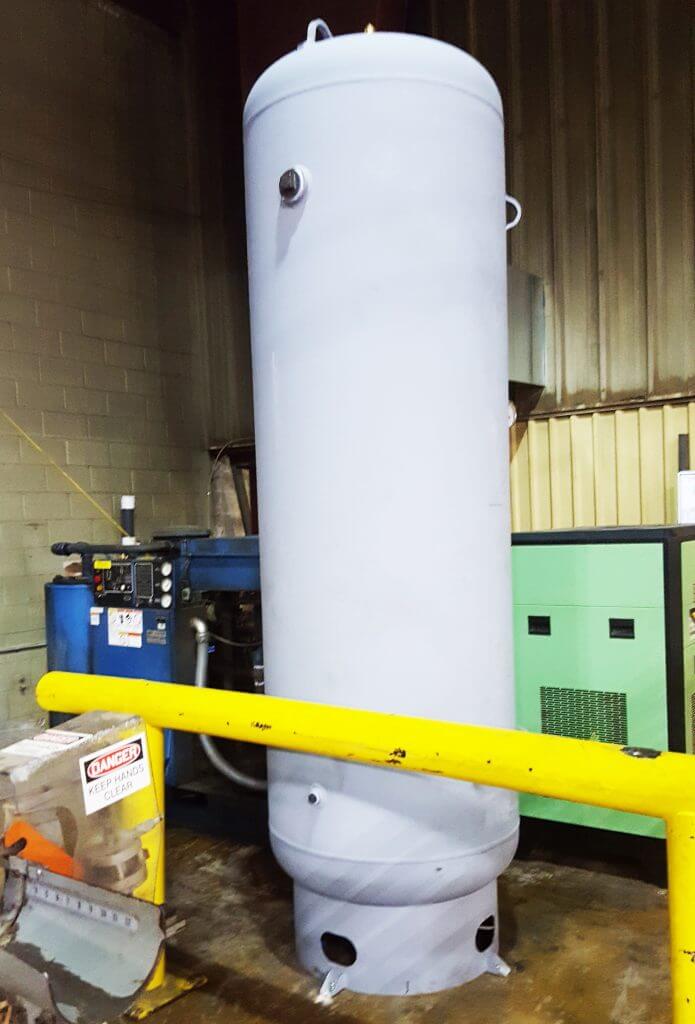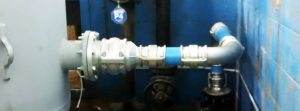October 3, 2017
Adding Storage to Old Compressed Air Systems Solves a Multitude of Problems
SHARE THIS POST
Adding Storage to Old Compressed Air Systems Solves a Multitude of Problems
Compressed air storage plays a critical role in increasing the reliability of your equipment and production efficiencies in your plant. Correctly implemented, adding compressed air storage can significantly enhance the accumulation, retention, and distribution of energy. When air compressors cycle properly and less frequently, energy consumption is greatly decreased. Another benefit is that control storage (aka wet storage) provides a buffer between the compressors and system demand. This allows time for the compressor’s controls to react to pressure fluctuations in the system. Lastly, air quality is enhanced as the “wet receiver” reduces the moisture content of the air prior to the dryers and filters.
Some folks might remember the days when many rotary screw air compressors were installed without air receivers. Back then, almost all rotary screw compressors operated with inlet valve modulation with a pressure differential tighter than the reciprocating compressors they were replacing. With no pulsation associated with rotary screw units, eliminating the cost of a receiver was also an advantage over piston compressors.
Case Study Example:
Recently, we started servicing a system for a manufacturer in South Baltimore who had two rotary screw compressors without air receivers; a 150 HP (compressor A) and a 100 HP (compressor B) that were piped to a refrigerated air dryer and a 4” main header supplying the plant. There was also another system, a 100 HP (compressor C) at the other end of the plant feeding a separate area.
Apart from all of these compressors not having air receivers, there were other issues with the old schedule 40 pipe system:
- Compressor A had a 2 ½” discharge that was reduced to 2”. The 2” discharge pipe ran down along the floor and elbowed up about 18’ to a 2” tee that was connected to compressor B. This caused a low area in the pipe with no way to drain condensate and a bottle neck at the 2” tee. After removing these pipe lengths, we discovered that they were packed with rust deposits; effectively reducing the inside diameter.
- Another issue was the lack of room to install an air receiver in compressor A & B’s area because of an old 50 HP unit that was previously installed. This 50 HP compressor was not large enough to serve as a backup for the plant; so we suggested they remove it to make room for the receiver. Once removed, a 1060 gallon wet (control) tank was installed after compressor A & B, prior to the refrigerated air dryer. Aside from the 1060 gallon wet (control) tank for the first system (Compressor A & B), we also installed a 500 gallon tank for Compressor C’s system at the other end of the plant.
- Lastly, we improved the condensate collection system, piped everything together with aluminum compressed air piping, and added oil / water separators to both systems to ensure compliance with Section 309 of the Federal Water Pollution Control Act.
Previously, compressor A & B (combined 250 HP) were both required to operate in order to maintain plant pressure. After the new receiver was installed, we were able to shut off the 150 HP unit (compressor A) and operate the entire plant with the 100 HP (compressor B). The total cost of the project was around $27K. The energy savings realized by turning off compressor A will pay for the entire project (both tanks, oil / water separator, piping, etc.) in less than 6 months.
By utilizing compressed air storage, you will lessen the demand needed to uphold peak performance, provide longevity to your equipment, increase productivity, and reduce operating expenses. If you have an older compressed air system that you feel could benefit from an air receiver, contact C.H. Reed today to schedule a free system analysis.
Search
Categories
Get a consultation
Related Posts
The 3 Distinct Advantages of Hydraulic Powered Pumps
Recently, C. H. Reed helped a major printing operation install a new ink pumping system. The new system needed to transfer four colors of high viscosity, heat-set ink to their three presses, drawing the ink from multiple 5,000…
Simple Ways to Reduce Waste in Your Spray Finishing System
In today’s demanding manufacturing landscape, it can be convenient to adopt a “cut-costs-at-all-costs” mentality, justifying questionable means for the sake of leaner production, a lower bottom line and increased profitability. Regrettably, those efforts can interfere…
What You Need to Know About Air-Powered Pressure Washers
Pressure washers are great solutions for your average cleaning applications, but what tool do you turn to for your more challenging applications? There are many instances where it is simply impossible to use a traditional…


